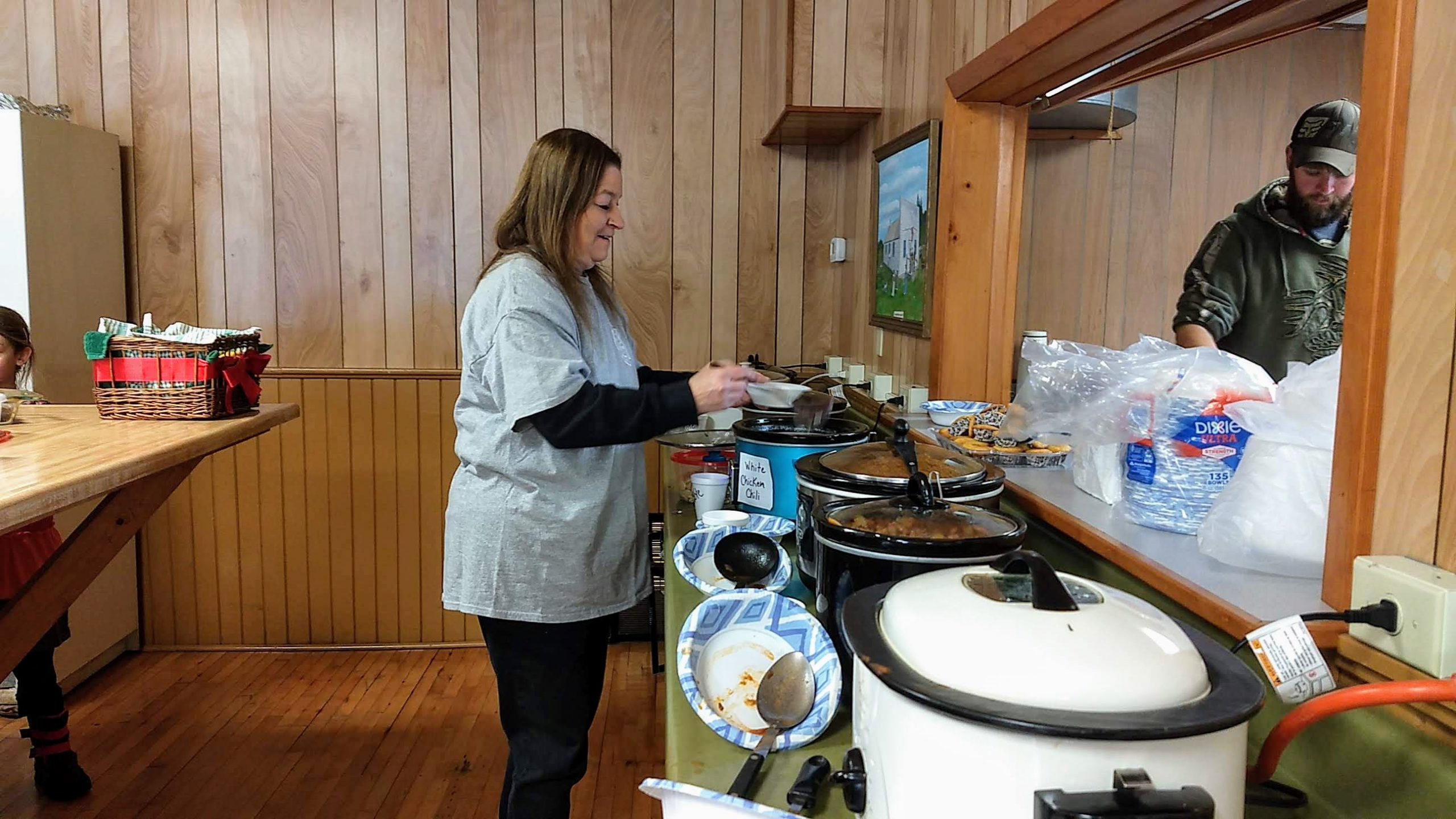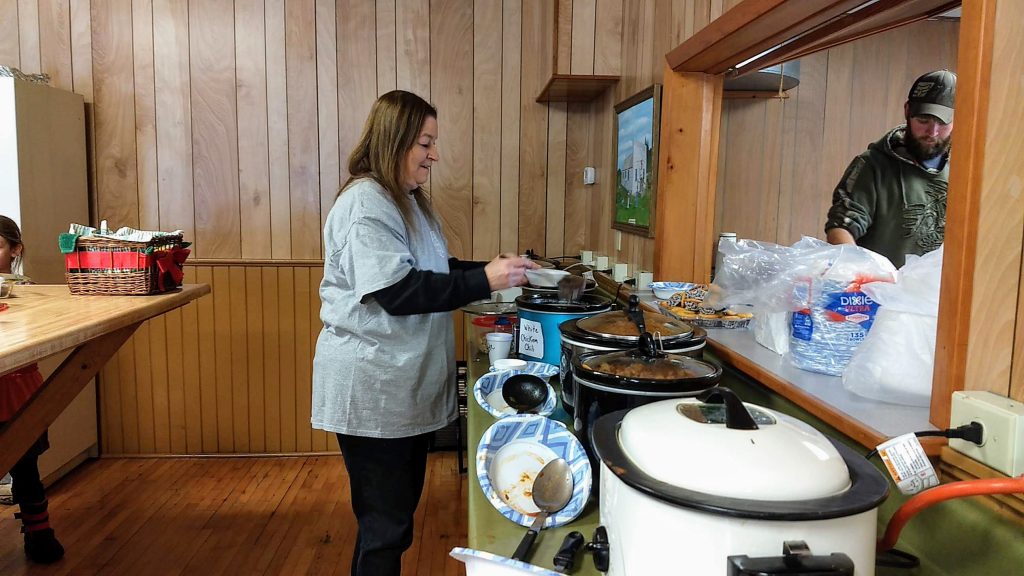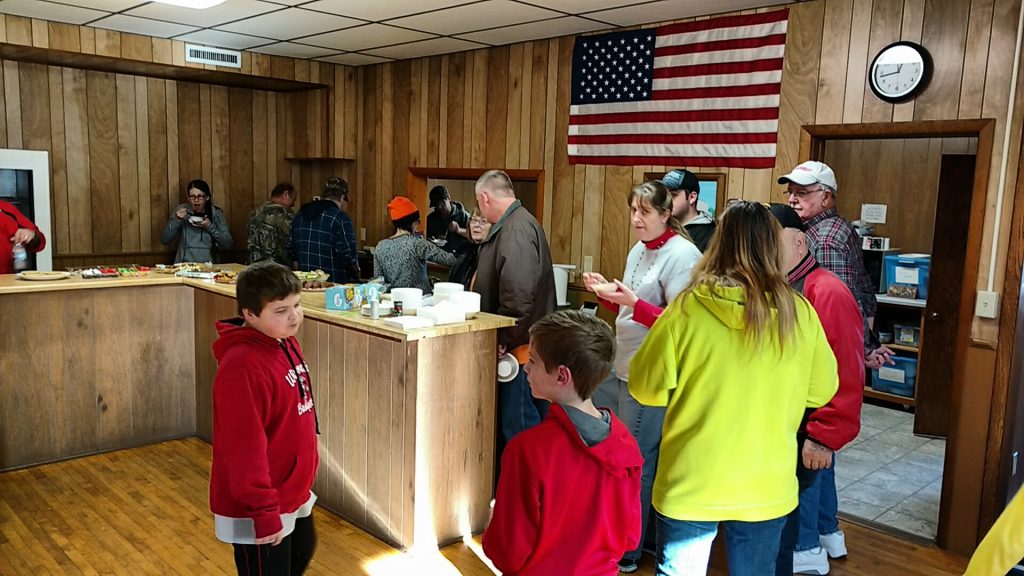How Food and Fellowship Are Evolving in Working Class Country Wisconsin
If you've ever eaten a funeral luncheon in a rural church basement, you're probably familiar with the gold standard in comfort food — funeral potatoes. It's hard to imagine anything more comforting than potatoes (fresh or frozen, hashed or tots) loaded with cheese, butter and sour cream. But in my corner of rural northern Wisconsin, those casseroles pale in comparison to the boiled spuds served when Ken Popelka passed away in 2019. For years, Ken grew extra potatoes in his large vegetable garden to donate to the annual St. Matthew's Lutheran Church fish boil. After his funeral, as volunteers serving the family-style meal placed bowls on tables they said, "These are Kenny's potatoes." Folks salted them with tears then started telling funny stories of a man who loved to grow food and share it with his community.
Food and fellowship are foundations of rural life. Every area seems to have its own traditions. This is the land of Friday fish fries (year-round, not just during Lent), of family-friendly taverns, of bratwurst and other remnants of German, Polish and Czech heritage. Area church cookbooks once were filled with recipes for potluck favorites like funeral potatoes. That makes sense, since our main agricultural products are dairy and seed potatoes.
In a county with a population just over 19,000, people here are likely to have personal connections with people who grow, transport, process, prepare, and sell or give away local agricultural products. Nevertheless, a surprising number now rely on foods available at gas station convenience stores. They eagerly await the arrival of DoorDash and other restaurant food delivery services now advertising for drivers in our county seat (population 7,780). Schwan's trucks deliver frozen meal items as well as ice cream to rural homes. If you can afford the products, having that distinctive yellow freezer truck stop at your place is a great convenience compared to the 50-plus-mile round trip to a supermarket.
But convenience is an expensive option where the median household income is under $50,000 and 13 percent of the population live in poverty. Bless the Ken Popelkas who raise more food than they need and share so generously — not just at church fundraisers but also one bag or box at a time. They're keeping alive another rural food tradition — neighbor helping neighbor.
Free Lunch Kids
The small rural school district where I live has about 145 students enrolled. Nearly 70 percent are considered economically disadvantaged. So each year at the district budget hearing, the community authorizes the school board to offer free breakfast and lunch to all students. We might disagree on some ways the district spends money and on larger social, economic, and environmental matters, but on this we are united.
My late mother would have approved. Mom was an elementary teacher in a school district a bit larger than this. Born during the Depression and raised during World War II, she never spent a nickel if she could spend a penny and save the rest. But even 30 years ago, societal changes were impacting her students. Working parents (like her) were too often sending kids to school without breakfast (not like her). Or they forgot or were unable to send the money for school lunches that teachers had to collect each week. "Free lunch kids" hated the label and what they thought it meant to their peers from families who were either able to pay or too proud to take a handout.
My mom once told me how grateful she was that, as a child, she never went hungry. Her family raised much of what they ate. In turn, that was how she and my dad raised their kids — on home-canned vegetables from the garden and meat from their livestock. "Convenience food" was smoked pork chops from the freezer, which my mom could throw in a pan and thaw enough to pry apart with a butter knife faster than you can get through the drive-thru at Dairy Queen.
A Baby Boomer-aged neighbor once gave my husband and me enough venison for a year after he and his grandkids all had successful hunts during the fall deer season. In thanks, I offered him a jar of tender home-canned venison in its own rich broth. That's a special treat to most folks I know. But not if you grew up eating gamey deer fed on poor winter forage because, to have meat for the family, your dad always had to shoot a deer in late spring.
Some of our rural neighbors have spent a lifetime hunting, fishing, and gardening to put food on the table. What others might view as recreation, they know as necessity. Some of those Free Lunch Kids are now elders struggling — again — to make ends meet. When illness, injury, weather, or other challenges impede their ability to grow or forage food, they may have to rely on other options. Before Covid, community nutrition services gave elders a chance to eat in fellowship with neighbors. Some use SNAP (Supplemental Nutrition Assistance Program) benefits to stretch fixed incomes that also have to cover housing, medical, transportation, and other costs of living. Until this August, when SNAP got its first major adjustment in the way it calculates benefits, the purchasing power of the plan was based on a model that hadn't changed since 1975.
The Next Generation
In 2020, supply chain concerns convinced many rural people to rethink where their food comes from. That March, as Wisconsin faced a stay-at-home order, I went to the supermarket in the county seat to stock up on fresh produce. And there, in the heart of potato country, you couldn't find a sack of spuds.
People who were too busy before bought chicks to raise and butcher themselves or to provide eggs. They hunted and fished. They scraped together the lump sum needed to fill freezers with beef halves and quarters from local farmers who managed to book processing slots at area butcher shops and locker plants. They persevered through the weeds of newly turned garden plots and through shortages of seeds and canning jars to learn about growing and preserving fruits and vegetables. Those one-time staples of rural culture may not have been practiced in some families for two or three generations — if ever.
The pandemic put a temporary stop to a lot of food-based community events. But they'll be back, those pancake breakfasts and harvest dinners. My favorite is our volunteer fire department's annual chili feed: Each firefighter family brings a pot of chili and a sweet treat. Since everyone contributes there isn't a heavy burden on a few volunteers to make everything, and the department doesn't incur a big expense. We invite our community to bring donations for the food pantry and their kids or grandkids for pictures with the fire trucks. Folks cast jingle bell "ballots" and there's some good-natured rivalry over whose chili will be voted "best" (bells are a fire department tradition, jingle bells are because the event is held in December). The chili recipes tell their own stories. There's the beefy recipe the chief's dad used to make when they owned a tavern. There's chili with and without macaroni, with venison, chicken, even wild turkey, and with different choices of beans. And usually several people, including my husband, add chopped celery to their chili. It's a Wisconsin thing.
Build Resilience in Communities
My community is lucky to have a small grocery store where you can pick up a sleeve of celery, if that's how you make chili, and much more. When I moved here in 1986, the market carried everything from canned goods to hardware. When the owners retired, the store sat empty for several years until it was bought by the current owner. He emptied the hardware aisle, added a kitchen, and does a brisk business in prepared food as well as groceries. But I worry that when he retires we'll become a food desert like so many other rural places.
Aging out is a nationwide concern up and down the food chain. In the last U.S. Census of Agriculture, primary producers over the age of 65 outnumbered farmers under 35 by more than 6 to 1. Locally, our farmers market relies heavily on a handful of aging Hmong growers, who regularly donate unsold vegetables to the food pantry. Last summer, a nearby U-pick strawberry farm closed after 40 years because the owners retired. What happens if we lose all of our local growers and lack the skill or the will to produce food ourselves?
The food system we've come to rely on for convenience and fresh strawberries year-round is vulnerable to everything from drought and wildfires to transportation disruptions. I'm not sure how many people even know that, once upon a time here in the Upper Midwest, you only ate fresh strawberries for a few weeks in summer. It was a season and a tradition we celebrated. Like tapping trees to make maple syrup each spring. Like a trip to the big lake for the smelt run. Like deer camp.
The same year that Ken Popelka died, we lost another beloved neighbor — a young man with three small kids. Folks had run a meal train to help the family during his illness so their freezer was well stocked. But that summer this area had suffered an extended power outage after a devastating derecho that left us with a tremendous fuel load from dead and down trees and warnings about elevated wildland fire risks for years to come.
That year, I couldn't help but think of my late mother-in-law. When my husband's dad died suddenly, she had four kids to feed and couldn't write a check for groceries because all their accounts were in her husband's name and were frozen upon his death. That's how things were back in those days. That's how things would be still if we, as a society, hadn't said it had to change.
If 2020 gave us an incentive to rethink our food system, maybe we can change that, too.
 Donna Kallner is a folk artist and writer from rural northern Wisconsin.
Donna Kallner is a folk artist and writer from rural northern Wisconsin.


